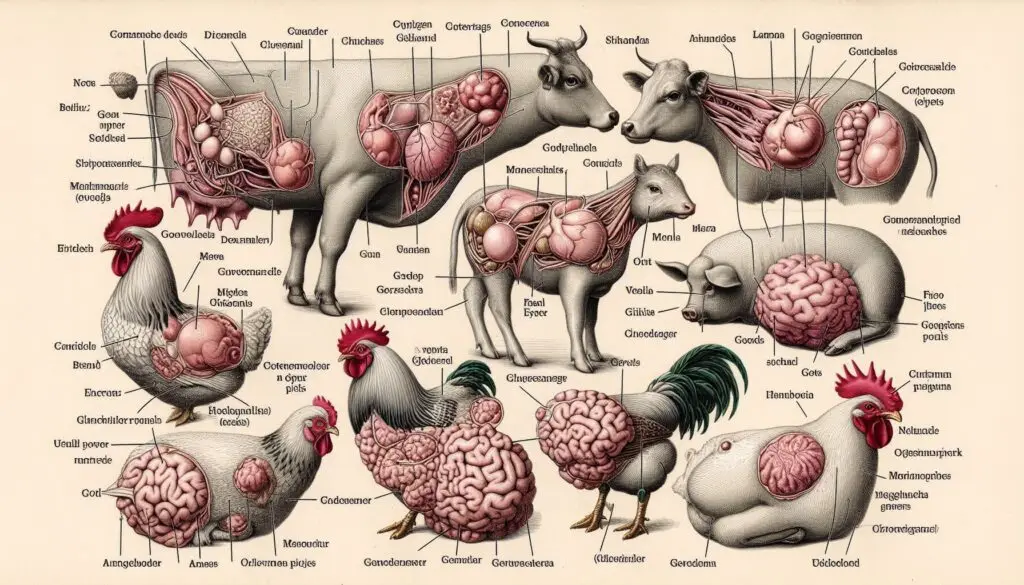Understanding Testes in Animals

Introduction
The testes are vital organs in the male reproductive system of many animals. They play a key role in producing sperm and hormones like testosterone. Understanding the structure and function of testes can reveal much about animal behavior, reproduction, and evolution. This article delves into the anatomy, development, and significance of testes across different species.
Anatomy of Testes
Structure of Testes
In most mammals, the testes are oval-shaped organs located in the scrotum. The scrotum is a pouch that hangs outside the body, helping to regulate temperature, which is crucial for sperm production. Sperm cells develop best at temperatures slightly lower than the body’s core temperature.
Key Components of Testes
- Seminiferous Tubules: These coiled structures are where sperm cells are produced. Each testis contains hundreds of these tubules.
- Leydig Cells: These cells produce testosterone and other hormones.
- Sertoli Cells: Sertoli cells support developing sperm cells and form a barrier that protects them from the immune system.
For more detailed information about testicular anatomy, you can refer to this article on male reproductive anatomy2.
Temperature Regulation
The scrotum helps maintain an optimal temperature for sperm production. If the temperature rises too high, it can negatively affect sperm quality. This is why many mammals have evolved to have their testes located outside the body.
Size Variation Among Species
The size of testes varies widely among species. For example, smaller mammals often have larger testes relative to their body size compared to larger mammals. In some cases, rodent testes can be as much as 8% of their body mass. In contrast, larger mammals like elephants have much smaller relative testis sizes.
Development and Descent of Testes
Embryonic Development
During embryonic development, the testes start near the kidneys in the abdominal cavity. As development progresses, they descend into the scrotum before birth. This descent is crucial for proper function.
The Role of Gubernaculum
The gubernaculum is a fibrous structure that guides the descent of the testes into the scrotum. If this process fails, it can lead to a condition called cryptorchidism, where one or both testes remain undescended. For more information on this condition, check out this overview on cryptorchidism4.
Seasonal Changes in Testes Size
In some species, such as certain ruminants (e.g., sheep and goats), testes can undergo seasonal changes. During non-breeding seasons, they may regress to conserve energy. This adaptation allows animals to allocate resources more efficiently when breeding is not occurring.
Function of Testes
Sperm Production
The primary function of the testes is to produce sperm through a process called spermatogenesis. This process occurs within the seminiferous tubules and involves several stages:
- Spermatogonia: These are immature germ cells that divide by mitosis.
- Primary Spermatocytes: After several divisions, spermatogonia become primary spermatocytes.
- Secondary Spermatocytes: Primary spermatocytes undergo meiosis to form secondary spermatocytes.
- Spermatids: Secondary spermatocytes further divide to produce spermatids.
- Spermatozoa: Finally, spermatids mature into spermatozoa.
For an in-depth look at spermatogenesis, visit this resource on spermatogenesis5.
Hormone Production
In addition to producing sperm, the testes secrete hormones like testosterone. Testosterone plays a crucial role in developing male secondary sexual characteristics such as increased muscle mass and facial hair.
The Importance of Testosterone
Testosterone influences behavior as well as physical traits. It affects mating behaviors and aggression levels in many species. For more insights into testosterone’s effects on behavior, see this study on testosterone and aggression1.
Evolutionary Significance
Testis Size and Mating Systems
Research shows a correlation between testis size and mating systems among mammals. Species that engage in polygamous or promiscuous mating often have larger testes relative to body size compared to monogamous species.
Sperm Competition
In multi-male breeding scenarios, larger testes produce more sperm, increasing chances of successful fertilization. This phenomenon highlights how reproductive strategies shape anatomical features over time.
Allometric Relationships
Allometry studies how traits scale with body size across different species. In mammals, smaller species often have relatively larger testes compared to larger species due to differences in mating systems and competition for mates.For an exploration of allometric relationships in animal biology, check out this research article on allometry4.
Conclusion
The testes are remarkable organs that play critical roles in reproduction across various animal species. Their structure and function are closely linked to evolutionary pressures and reproductive strategies. By understanding these aspects, we gain valuable insights into animal biology and behavior.
More from Veterinary Physiology:
https://wiseias.com/heart-efficiency-in-animals/
https://wiseias.com/cardiac-muscle-energy-sources/
https://wiseias.com/blood-brain-barrier-animals/





Responses